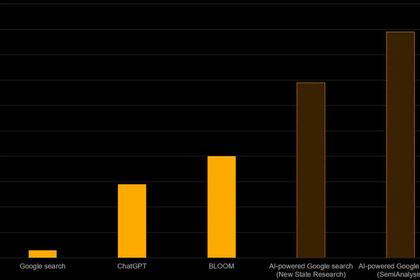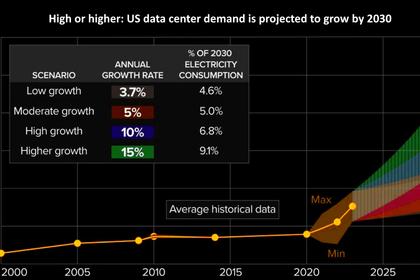
AI ENERGY MANAGEMENT

By Hugo Stappers Global Sales Leader - Energy Portfolio Management, Hitachi Energy
ENERGYCENTRAL - Sep 26, 2024 - Artificial Intelligence (AI) is transforming the energy sector, fundamentally changing how power is generated, distributed, and consumed. AI is driving the industry toward greater efficiency, sustainability, and security. As renewable energy assets increasingly challenge traditional energy models, staying competitive in this shifting landscape requires advanced technological solutions.
Accurate predictions are crucial for driving increased revenue in today’s energy markets. As renewable energy assets disrupt traditional models designed around predictable thermal generation, the complexity of staying competitive has grown significantly. Energy traders and asset managers can no longer rely on outdated models that struggle to manage the uncertainty introduced by renewables. These older systems often fail to consolidate the vast amounts of data required for informed decision-making and lack the ability to incorporate key elements such as asset performance predictions, price forecasts, and risk mitigation recommendations.
In a market characterized by increasing competition and volatility, investing in advanced analytics and machine learning technologies is essential for improving the buying (bids) and selling (offers) in the market. According to industry insights, leveraging advanced analytics, particularly in short-term and intraday power trading, can be the difference between profitability and substantial income shortfalls. Unlike traditional power sources, renewable energy generation is highly variable, influenced by regional factors such as weather patterns, cloud cover, and wind speed. This variability makes it challenging to predict energy output, further emphasizing the need for sophisticated AI-driven tools to enhance forecasting accuracy and optimize market participation.
Energy Portfolio Management is an interplay between market insights, forecasting, asset modelling, asset optimization, energy trading and risk management through market communications, and as AI continues to evolve its integration into those systems, it is reshaping how companies manage their portfolios. Here are some examples where AI is enhancing forecasting, trading, flow optimization, and settlement processes, positioning it as a crucial tool in navigating the complexities of today’s energy landscape.
The Evolution of AI in Energy Management
There may be no hotter topic in 2024 than Generative AI. AI itself has been a part of the technological landscape for decades, but its applications in energy management have gained significant momentum in recent years. Machine Learning (ML), often considered a modern application of AI, allows systems to access vast amounts of data and learn from it autonomously. This ability to self-improve based on data inputs is particularly valuable in energy trading, where both rule-based systems and ML-driven approaches can automate tasks and generate insights that were previously unattainable.
AI-Powered Forecasting
Outdated forecasting models and systems often struggle to manage the unpredictability of renewable energy. These models fail to consolidate the vast amounts of data needed to make accurate predictions, which is essential for forecasting. Neural networks, a subset of AI, have been instrumental in the development of sophisticated forecasting models. These models mimic human cognitive functions by processing data and making probabilistic predictions. In the energy sector, neural networks are utilized for short-term load, generation, and price forecasting, leveraging historical price data, demand trends, weather forecasts, and calendar attributes.
For regression forecasts, industry-leading solutions validate multiple algorithms in parallel using data science best practices. Key performance measures, such as Mean Absolute Percent Error (MAPE), Mean Absolute Error (MAE), Root Mean Squared Error (RMSE), and R Squared (R²), are employed to assess the accuracy of these models. This rigorous approach ensures that the most reliable forecasting model is selected, leading to highly accurate predictions that drive better decision-making in energy markets.
The process involves training models on historical data, optimizing them, and validating their accuracy before applying them to new data sets. The result is forecasting precision that significantly enhances the ability of energy traders and portfolio managers to anticipate market movements and adjust their strategies accordingly. Sometimes, effectiveness and precision can be further improved by, ironically, human intelligence augmenting the artificial intelligence to fine tune and/or properly run models, with the help of experts with detailed knowledge of market development but also how to model and analyze them, providing a unique combination of software, data and advisory services.
Trading and Portfolio Optimization
AI plays a pivotal role in analyzing the complex dynamics of energy trading, processing vast amounts of real-time data related to pricing, demand, and supply trends. By doing so, AI enables energy companies to make more informed and profitable trading decisions. In addition to optimizing portfolios, AI excels in risk management, offering proactive assessments of market volatility and uncertainties. Algorithmic trading systems powered by AI can execute trades at lightning speed, completing transactions in milliseconds, far outpacing human traders.
Beyond speed, AI brings depth to portfolio optimization by simulating market scenarios, analyzing sentiment, automating routine tasks, and continually adapting to changing market conditions. One of its greatest strengths lies in its ability to identify patterns and trends within large datasets. This advanced pattern recognition allows AI to detect emerging market opportunities and risks that could easily escape human traders. As a result, AI’s capacity to provide timely insights and strategies is invaluable in navigating the dynamic and increasingly volatile energy market.
AI's role in trading revolves around the deployment of complex algorithms capable of optimizing operations. Portfolio optimization, in particular, is a critical application of AI, used to optimize the dispatch of various assets and enhance the performance of these optimizations by incorporating stochastics and machine learning. This approach allows for more accurate modeling and prediction of market behavior, ultimately leading to improved decision-making and profitability.
A key aspect of this optimization process involves the use of Mixed Integer Linear Programming (MILP) algorithms. These are crucial for accurately modelling intricate assets like Combined Cycle Gas Turbines (CCGTs) and cascading hydro systems. Unlike traditional simulation methods that offer only localized solutions, AI-driven algorithms provide comprehensive optimizations, enabling traders to maximize profits across their portfolios.
Next-generation ETRM systems integrate these advanced algorithms to simulate "What-if" scenarios, allowing traders to assess the potential impact of market changes on their portfolios. Real-time data feeds and direct connections with trading exchanges further enhance decision-making by providing up-to-the-minute insights.
Flow Optimization in Energy Networks
Optimizing gas flow within energy networks is another area where AI demonstrates its value. Linear programming techniques, such as Dantzig’s simplex algorithm, are employed to optimize the scheduling of gas from receipt to delivery points. These AI-driven systems consider constraints like pipeline capacity, contracts, and supply-demand dynamics to propose optimal flow paths. This not only automates complex scheduling tasks but also ensures that energy demands are met efficiently, reducing operational costs and improving supply reliability.
Managing Renewable Energy Certificates
The management of Energy Attribute Certificates (EACs), including Guarantees of Origin (GOOs) and Renewable Energy Certificates (RECs), has become increasingly important as the world shifts towards renewable energy. AI-enhanced EAC management systems, capture essential registry attributes and automate the matching of power deals with the appropriate certificates. This capability is crucial for maximizing trading opportunities across multiple jurisdictions with different regulations and exchangeable EACs, thereby further facilitating the use of EACs being recognized tools for companies to report reduced greenhouse gas (GHG) emissions. Incidentally, this applies also to the Data Centers supporting the increase in AI powered solutions, and thereby leverage that same power of AI to measure their impact and identify credible levers to reduce their carbon footprint. As quantifying GHG emissions is complex it takes robust carbon accounting software.
Streamlining Settlement with AI (enabling RPA)
Rule-based systems are a basic type of AI model that uses a set of prewritten rules to make decisions and solve problems. Incorporating AI into settlement processes enable Robotic Process Automation (RPA) and has revolutionized back-office operations. Rule-based systems, enhanced by AI, automate routine tasks such as invoicing, contract management, and billing. When integrated with a comprehensive ETRM system or build-for-purpose settlement solution, these AI-driven processes facilitate straight-through processing and workflow management, drastically reducing the need for manual intervention. This not only speeds up operations but also minimizes errors, allowing companies to maintain a high standard of operational excellence.
Rising role of AI
The integration of AI into energy portfolio management has and is transforming how the industry operates, offering enhanced efficiency, accuracy, and profitability. As a result, it improves revenues, where even a 1% increase in accuracy can mean millions of dollars. From forecasting and trading to flow optimization and settlement, AI-driven technologies are now essential components of Energy Portfolio Management. As AI continues to evolve, its role in energy management will likely expand, offering even more sophisticated tools to navigate the complexities of the energy market.
-----
This thought leadership article was originally shared with Energy Central's Digital Utility Community Group. The communities are a place where professionals in the power industry can share, learn and connect in a collaborative environment. Join the Digital Utility Community today and learn from others who work in the industry.
------
Earlier:


















